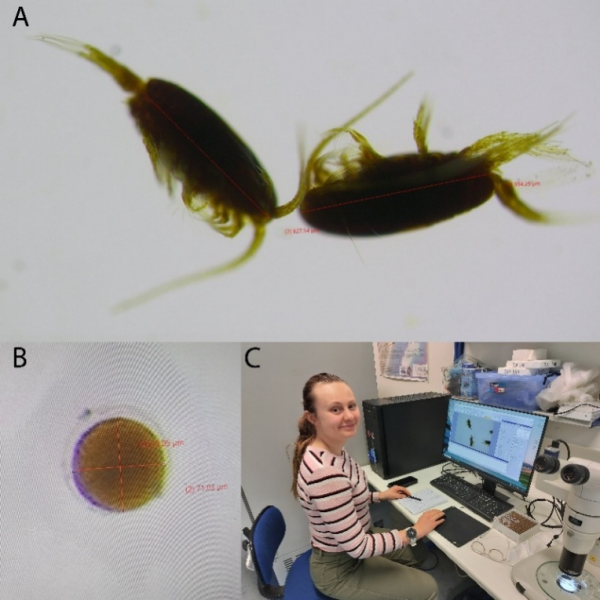Studying zooplankton from the ‘natural laboratory’ in Méthana, Greece: setting up a novel project

PhD student Henna Yliluikki and Jonna Engström-Öst, the team leader of the Blue Ecosystems team from the Faculty of Bioeconomy, visited Greece 14–28 February to begin a new project. The aim of this journey was to conduct preliminary field and laboratory work and familiarize with the specific conditions of the seawater at the venting site in a volcanic area in Greece.
The newly started project, ZETA - Losing weight? Eco-physiology and transcriptomics reveal climate forcing on lipid profiles and adaptation in marine biota, is funded by the Research Council of Finland and it consists of three sub-projects. This project focuses on the eco-physiological responses of zooplankton in adaptation to climate change. Marine biota suffer especially from ocean warming and acidification. Zooplankton, particularly copepods, are key grazers in the ocean and play a fundamental role in the marine food-web. They are the link between primary producers and higher trophic levels, as they effectively prey on microalgae that contain omega fatty acids. Omega fatty acids, known as polyunsaturated fatty acids, are essential for zooplankton growth, survival, and reproduction, and they also have a significant impact on higher trophic levels, including the marine food sources, such as fish that humans rely on.

Figure 1. A) CO2 bubbles seeping from the sea floor decreasing pH of the specific site, B) Sampling of zooplankton with the net.
Field and some laboratory working for one of the sub-projects of ZETA, called Méthana, among the location, where zooplankton samples are collected, is conducted in Greece.The Mediterranean Sea locates in a seismically active area, causing volcanic activity that has led to the formation of the Hellenic Arc in the southern Aegean Sea. This includes volcanic islands such as Santorini, Nisyros, and Méthana. Due to volcanic activity, CO2 is seeping from the seabed near Méthana, decreasing the pH of the seawater at this specific site (Fig. 1A). The site can be used as a natural laboratory to model future ocean conditions that are predicted to occur globally in year ~2100. Marine species, in this case zooplankton, inhabiting this area, have been under long-term exposure to low pH, allowing us to investigate their long-term adaptation. Volcanic activities often emit other gases, such as methane and sulfuric compounds, seeping into seawater, which can negatively affect biota. However, the concentrations of harmful methane, sulfuric compounds and carbon monoxide are lower in Méthana, compared to other similar study sites, such as Ischia in Italy.
During the first week of our trip, we conducted fieldwork for sampling and measuring oceanographic variables, such as pH, temperature, alkalinity and chlorophyll a. We sampled five different sites around the Méthana peninsula together with our collaborators Tanya Zervoudaki and Thodoris Zoulias from the Hellenic Centre for Marine Research (HCMR) and with the help of a local fisherman. Zooplankton community samples and samples for species selection with microscope were collected using a net, as shown in Figure 1B. This was our as well as our collaborators’ first time in Méthana.

Figure 2. A) Body length and B) egg size of Clausocalanus, measured from microscope images, C) Henna Yliluikki measuring length of zooplankton from microscope image.
In the later part of our trip, we worked in the laboratories of HCMR in Anavyssos and at the Department of Environmental Chemistry in the National and Kapodistrian University of Athens. Alkalinity, which refers to the buffering capacity of water against acid or base, was measured with the assistance of Aikaterini Sakellari. Chlorophyll a measurement and microscopy for measuring the length of female zooplankton (Clausocalanus) and egg diameter were carried out at HCMR (Fig. 2).
We received valuable information for preparing a detailed research plan to conduct official sampling next spring. For example, we learned how to organize liquid nitrogen to freeze samples for more versatile laboratory analyses and identified potential reference sites without impact of volcanic gases on seawater. This project is the first to study zooplankton in Méthana, and we are excited to continue our research.
Reseskildringen har godkänts för publicering av Novias redaktionsråd 16.4.2025.
ISSN: 2670-028X
![]()
Reseskildringen har publicerats i Novias publikationsserie RS: Reseskildringar. Inläggen har godkänts av Novias redaktionsråd.
Novia Publikation och produktion, serie RS: Reseskildring, ISSN: 2670-028X
Vi följer CC_BY 4.0 om inget annat nämns.